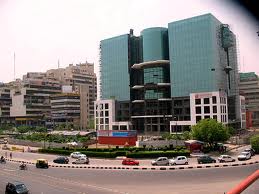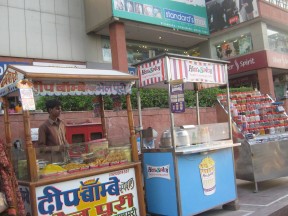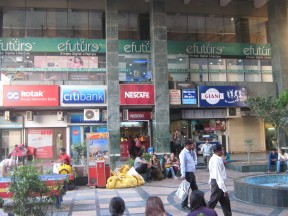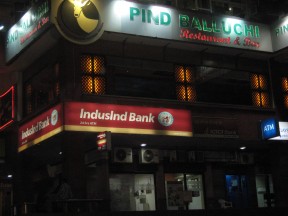 Netaji Subhash Place at Pitampura, flush by Wazirpur Depot on the Ring Road, is perhaps the only commercial complex in Delhi to felicitously combine the attributes of an office complex, shopping hub and food court. The complex, along with the expanse of assorted shops selling an eclectic mix of clothes, jewellery, street food of all kinds, sweets, household gadgets as also provision stores, realtors, automobile dealers, photographers, restaurants, bakeries, electronics, tuition bureaus, hobby classes, specialized coaching centres and pavement bookstalls, that stretch from Wazirpur Depot on Ring Road (inner) to Madhuban Chowk on Outer Ring Road, constitutes what has been dubbed ‘North Extension’ or simply ‘North-Ex’, as a counterpoint to the ‘happening’ South-Ex.
Netaji Subhash Place at Pitampura, flush by Wazirpur Depot on the Ring Road, is perhaps the only commercial complex in Delhi to felicitously combine the attributes of an office complex, shopping hub and food court. The complex, along with the expanse of assorted shops selling an eclectic mix of clothes, jewellery, street food of all kinds, sweets, household gadgets as also provision stores, realtors, automobile dealers, photographers, restaurants, bakeries, electronics, tuition bureaus, hobby classes, specialized coaching centres and pavement bookstalls, that stretch from Wazirpur Depot on Ring Road (inner) to Madhuban Chowk on Outer Ring Road, constitutes what has been dubbed ‘North Extension’ or simply ‘North-Ex’, as a counterpoint to the ‘happening’ South-Ex.
An obscure, unheard-of, downmarket locality till about two decades ago, North-Ex is now an integral part as well as the face of the changing realities of the capital. One of the first areas to be served by the Delhi Metro, it has grown by leaps and bounds. Today, with its easy access to upcoming trendy residential complexes by the best builders, schools, cultural centres, movie theatres, malls, adventure parks, restaurants and newest five star hotels, it is rapidly coming up as the place to be in the Capital.
 Thus runs the story of Delhi. At one time, it used to be Chandni Chowk market for traditional finery and jewellery; Pahar Ganj for chaat and chhole bhature; Jama Masjid for traditional non-vegetarian food; Karol Bagh, Kamla Nagar and Lajpat Nagar markets for medium-range everyday shopping; Defence Colony market, Khan Market, GK market and South Extension (South-Ex) market for the fashionistas and trendsetters; and Sarojini Nagar Market for patri or pavement shopping. And at the heart of it was Connaught Place, where it all came together, and where you could do it all at the same place. This was at a less congested time when the population of Delhi was less than a million and the capital stretched from the Yamuna River in the east to Najafgarh village in the west, and from Pithampur village (now Pitampura administrative zone) in the north to Mehrauli in the South.
Thus runs the story of Delhi. At one time, it used to be Chandni Chowk market for traditional finery and jewellery; Pahar Ganj for chaat and chhole bhature; Jama Masjid for traditional non-vegetarian food; Karol Bagh, Kamla Nagar and Lajpat Nagar markets for medium-range everyday shopping; Defence Colony market, Khan Market, GK market and South Extension (South-Ex) market for the fashionistas and trendsetters; and Sarojini Nagar Market for patri or pavement shopping. And at the heart of it was Connaught Place, where it all came together, and where you could do it all at the same place. This was at a less congested time when the population of Delhi was less than a million and the capital stretched from the Yamuna River in the east to Najafgarh village in the west, and from Pithampur village (now Pitampura administrative zone) in the north to Mehrauli in the South.
And then came the decade of the 1990s, and with it, the spread of Delhi in all directions. As immigrants from rural to urban areas who initially used to flock to Mumbai—the country’s de facto industrial capital—in search of livelihoods, grew insecure in the wake of Shiv Sena’s activities, the more secular and tolerant Delhi with its rapidly developing infrastructure, industries, employment prospects and facilities became the country’s new ‘land of opportunity’.
 In the past two decades, the population of the city has soared from 0.82 million to nearly 19 million at the most recent count. And to accommodate the burgeoning population, the city has extended itself to its present area of 1483 square kilometres, initially spanning the Yamuna and spreading to its eastern side, and then engulfing neighbouring towns and areas such as Noida, Greater Noida, Ghaziabad, Faridabad, Badarpur, Bahadurgarh, Sonipat and Gurgaon into the National Capital Territory (NCT) Delhi. And this is the present Delhi—an extremely congested cosmopolis, with an average population density of over 9000 persons per square kilometres, and a highly developed public transport system as well as network of roads which, however, falls perpetually short of the requirements of its almost impossibly dynamic populace!
In the past two decades, the population of the city has soared from 0.82 million to nearly 19 million at the most recent count. And to accommodate the burgeoning population, the city has extended itself to its present area of 1483 square kilometres, initially spanning the Yamuna and spreading to its eastern side, and then engulfing neighbouring towns and areas such as Noida, Greater Noida, Ghaziabad, Faridabad, Badarpur, Bahadurgarh, Sonipat and Gurgaon into the National Capital Territory (NCT) Delhi. And this is the present Delhi—an extremely congested cosmopolis, with an average population density of over 9000 persons per square kilometres, and a highly developed public transport system as well as network of roads which, however, falls perpetually short of the requirements of its almost impossibly dynamic populace!
The combination of the city’s sheer geographical spread and its extremely high population density resulted in the inevitable outcome. No longer were these ‘specialized’ markets sufficient to serve the needs of the people of the city. The interminable commutes and the humungous traffic jams clogging the roads spawned the universal demand for everything much closer home, even if it came with a higher price tag—anything to avoid a needless tussle with the traffic in extreme weather!
And so came the era of self-sufficient markets in every area of the city, preceding the ‘mall culture’. No more trudging through the alleys of Chandni Chowk and Karol Bagh for wedding finery—Ushnak Mal Mool Chand, Rati Ram Ram Vinod, Ram Chandra Krishna Chandra, and now Chhabras and Narangs all have outlets in various parts of the city, as do all the top jewellers, plus a host of new ones. No more battling the traffic to browse the pavement markets at Sarojini Nagar and Lajpat Nagar—you have it all at almost walking distance! And no more lugging the family to Connaught Place for a Nirula’s ice cream or to South-Ex for Baskin Robbins. Nirula’s and Baskin Robbins (along with the newest ice-cream chain, Giani’s) have all come to your doorstep, so to speak—either in a market accessible almost on foot, or at the nearest mall. And even today, though nuclear families with little children might find air-conditioned, brightly decorated malls with the latest trendy retail outlets and play areas more convenient, really avid shoppers worth their salt still prefer to browse the open air markets for their needs as well as for unexpected surprises and treasures.
 It was in this era that North and West Delhi, considered slightly infra dig till about two decades ago by inhabitants of Central and South Delhi, started coming into their own. From being looked down upon as the bastions of ‘refugees’ (from Punjab) and laalas (residents of the old, walled city relocating to escape the congestion), these most thickly populated localities of the Capital became, almost overnight, the most promising markets in post-liberalization Delhi. The original ‘refugees’ and lalaas with their immense drive and ‘go-getter’ spirit made it good and have been replaced by their second and third generations, now living amid the city’s most modern civic infrastructure and cosmopolitan amenities (the last to be developed, hence, the best).
It was in this era that North and West Delhi, considered slightly infra dig till about two decades ago by inhabitants of Central and South Delhi, started coming into their own. From being looked down upon as the bastions of ‘refugees’ (from Punjab) and laalas (residents of the old, walled city relocating to escape the congestion), these most thickly populated localities of the Capital became, almost overnight, the most promising markets in post-liberalization Delhi. The original ‘refugees’ and lalaas with their immense drive and ‘go-getter’ spirit made it good and have been replaced by their second and third generations, now living amid the city’s most modern civic infrastructure and cosmopolitan amenities (the last to be developed, hence, the best).
The current inhabitants of these areas, thus, have the advantages of both, the money and luxury provided by their progenitors and the most updated infrastructure and civic amenities provided by the government. They have studied in the best schools, imbibed the global culture and have brought together the choicest elements of commercial, industrial and cultural development into ‘their area’—shopping complexes, offices, eateries, malls, adventure parks, movie halls; even Dilli Haat—and all conveniently located to be accessible from the Delhi Metro! ‘North-Ex’, thus, truly epitomises the ‘immigrant revolution’ that is underway in Delhi.





